Exotic sea shells are so delicate, exquisite and amazingly diverse! Sun-drenched, caressed by the waves, keeping the secrets of unknown depths. It is not surprising that it is customary to take them as a memory of travel to the sea. Probably, each of us has a treasured box with these embodied memories ... And how nice it is to open it on a cold winter evening, smooth the pearly sides of the shells with your fingertips, put one of them to your ear and hear the distant, barely audible song of the sea. ..
But now the summer is in the yard (yes, I insist)! Time for interesting travel, new acquaintances, bright impressions, a time of joy. And what can please a woman more than a new bag? Especially the beach bag
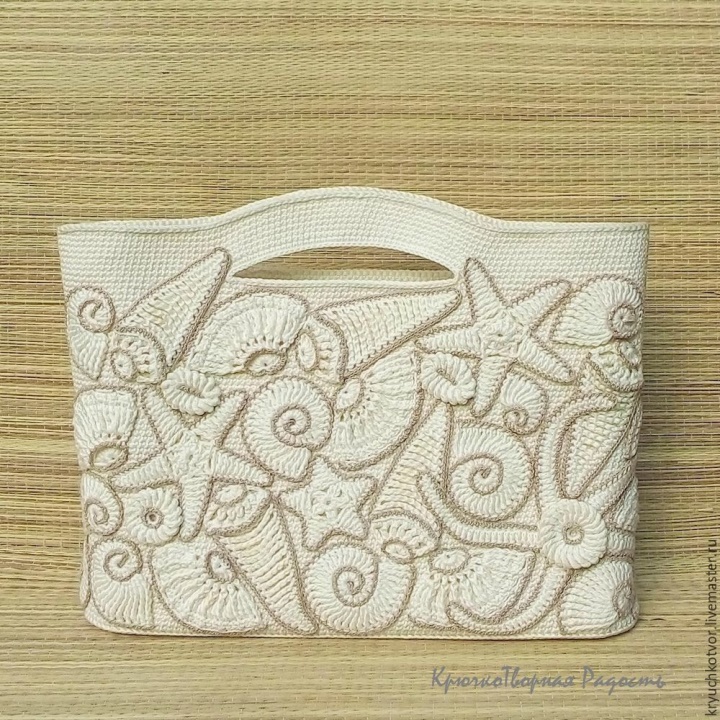
Therefore, taking into account all of the above and discarding the lyrics, I suggest that you decorate the beach bag today with man-made (or, rather, pettifogging) shells and starfish. What do we need for this?
First, we need a bag. You can tie it with crochet from cotton or linen, or sew from dense textured fabric, or buy ready, or get your old favorite beach bag from the furthest shelf of the wardrobe and give it a new life. The choice is yours!
I will decorate here such a laconic handbag measuring 36 by 28 cm, tied with a crocheted mercerized cotton milk, with an oval bottom and knitted handles.
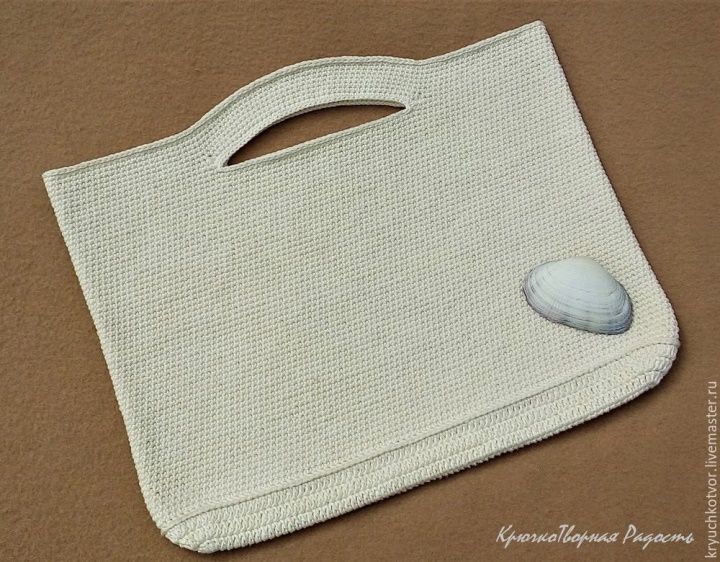
Secondly , we need a suitable yarn for our shells and starfish. I propose to take a wonderful cotton thread Charm from Vita Cotton (50g / 106m) color # 4153 dairy (from this yarn, by the way, my bag is tied), and for a fine thin cotton thread Anna 16 from Seam (100g / 530m) color No. 284 beige.
Third , we will need knitting hooks - No. 2, 5 for the first thread and No. 1 for the second.
Well, any little things without counting - reel thread, needles, scissors and necessarily - a good mood!
So, we begin! (I apologize in advance for the different background colors on the collages and other amazing things that happened to my photos - shot under natural light, and it changes in our wonderful summer weather every five minutes.)
We knit a shell-spiral
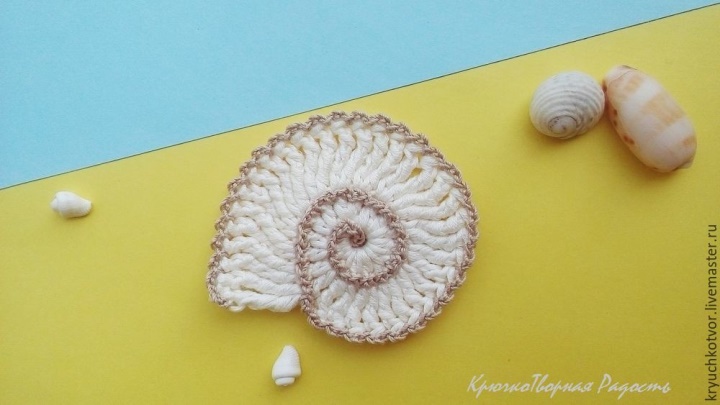
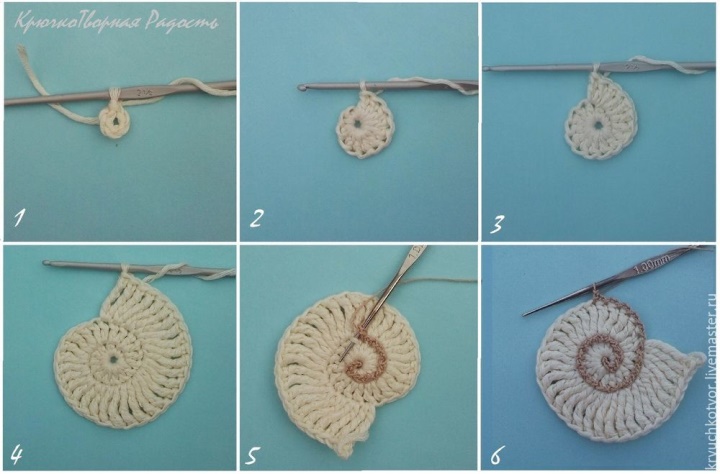
We dial a chain of five air loops, we enclose in a ring.
We make one lifting loop and knit in this ring in sequence: two columns without a crochet, two half-columns with a crochet, eight columns with a crochet-only 12 sticks.
We knit in a spiral in the columns of the previous row, two bars in each loop of the base: four times two columns with a crochet in each loop - only eight columns with a crochet.
We continue to knit in the same way: five times two bars with two crochet in each loop - only ten sticks with two crochets; eleven times two bars with three cords in each loop - only twenty-two columns with three crochets.
We tie our shell with a thin thread in a spiral, beginning from the center, alternating two air loops and half-loops without a crochet in each column, hooked by its upper outer loop.
The outer edge is tied, alternating two air loops and half-loops without a crochet in each loop of the base.
We knit a shell-bivalve
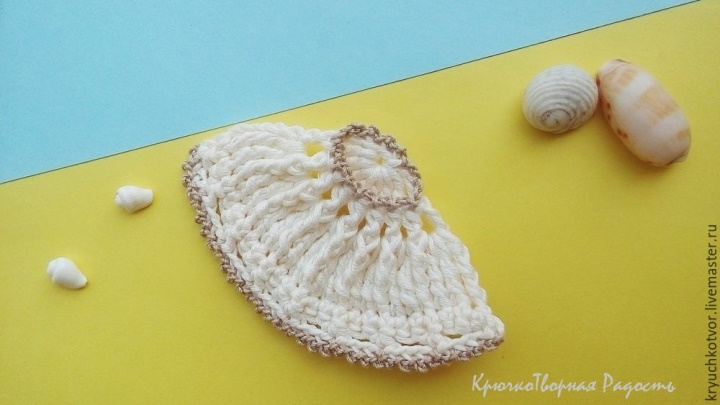
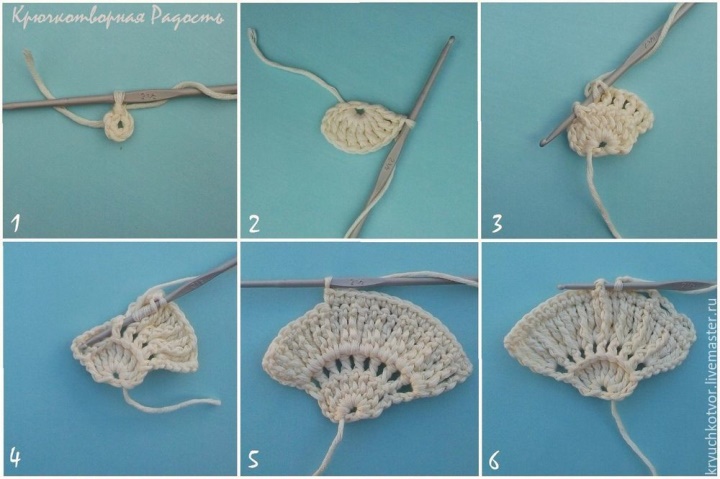
We dial a chain of five air loops, we enclose in a ring.
We make four lifting loops and knit eight columns with two crochets in this ring.
Without closing the knitting, turn it and knit the second row: three lifting loops plus one more air loop, then alternate - one relief facial column with a crochet in each loop of the base of the previous row, one air loop; we end the row with a column with a crochet in the lifting loops of the previous row. Attention! When knitting a raised facial column, grasp the thread not by the body of the lower column, but by the bridge between the loops of the base of the previous row.
Turn knitting, we knit the third row: five lifting loops, two columns with three tops in a picot from the air loop of the previous row, one relief facial column with three crochets in a column with a crochet of the previous row (this time with the knitting we grab the body of the lower column); alternate to the end of the series, we end with a column with three tops in the lifting loops of the previous row.
We turn knitting, we knit the fourth row: one lifting loop, one column without a crochet in each loop of the base of the previous row.
We turn knitting, we knit the fifth row: one lifting loop, then alternating - three air loops, one relief facial column without a napkin in every third column of the previous row; we end the row with a column without a crochet in the lifting loop of the previous row.
We tie the top of the shell and its edge with a thin thread in the same way as described above.
We knit the nautilus shell

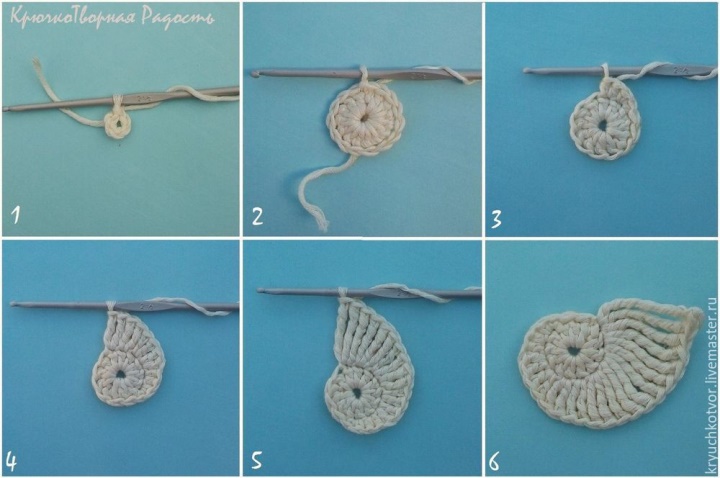
We dial a chain of five air loops, we enclose in a ring.
We make three lifting loops and knit twelve columns with a crochet in this ring, close the row with a connecting post.
We knit one lifting loop and then sequentially into each column of the previous row: two columns without a crochet in one loop of the base, two half-columns with a crochet in one loop of the base.
We continue: two columns with a crochet in one loop of the base - twice, two columns with two crochets in one loop of the base - two times.
We continue: three columns with three crochets in one loop of the base, three columns with four crochets in one loop of the base.
And finish: three posts with five crochets in one loop of the base, three posts with six crochets in one loop of the base.
We tie a nautilus shell with a thin thread in the same way as a spiral shell was tied.
We knit the conch shell
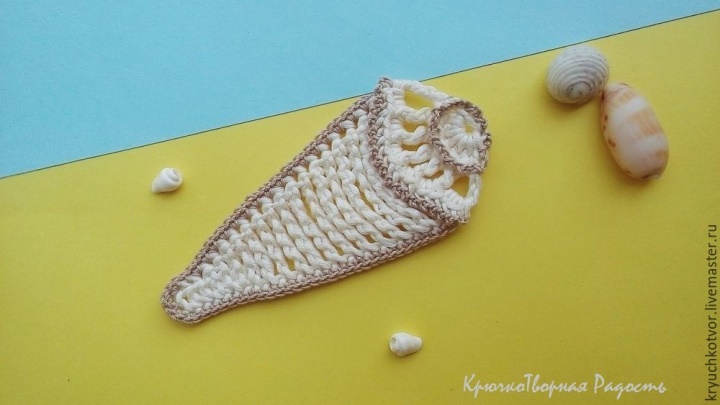
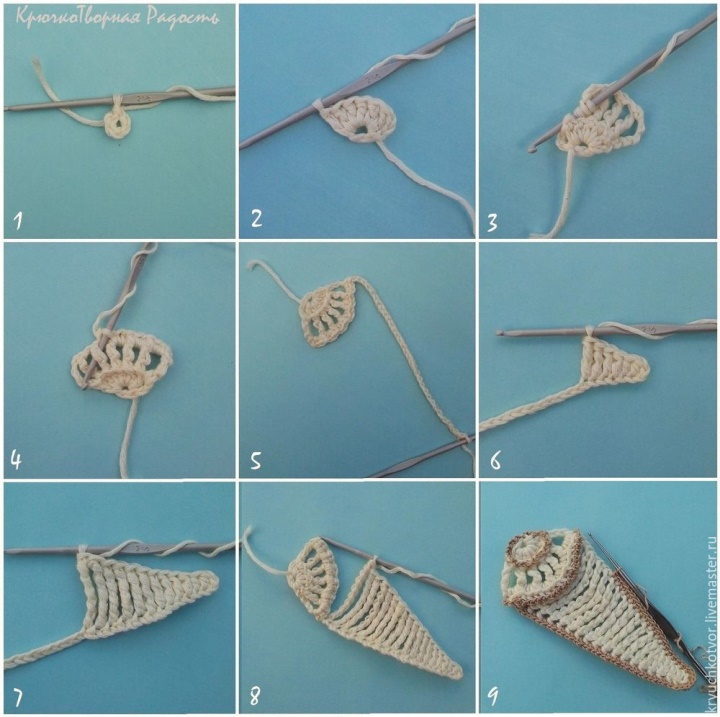
We dial a chain of five air loops, we close in a circle.
We make three lifting loops and we knit six columns with a crochet in this ring.
Without closing the knitting, turn it and make four lifting loops plus one loop, then alternate - one relief facial column with two crochets in each loop of the base, one air loop; we end the row with a column with two tops in the lifting loops of the previous row. Attention! When knitting a raised facial column, grasp the thread not by the body of the post, but by the bridge between the loops of the base of the previous row.
We turn knitting, we knit the third row: one lifting loop, two stitches without a crochet in a picot from the air loop of the previous row, one embossed facial column without a crochet in a column with two crochets of the previous row (this time we grab the body of the column with knitting); alternate to the end of the row, we finish with a column without a crochet in the lifting loops of the previous row.
Do not break off the thread, we recruit a chain of thirty-two air loops.
We knit in this chain sequentially, one post in each loop, starting from the third from the hook: two half-columns with a crochet, two columns with one crochet, two posts with two crochets.
Continue, now one bar in each second loop of the chain: two bars with three capes, two pillars with four capes, two pillars with five capes.
And finish: two posts with six crochets, two sticks with seven nacs, two sticks with eight crochets; make the connecting column in the last column without the cusch of the previous row.
We tie the top of the shell and its bezel with a thin thread in a way familiar to us; the whole body of the cone is tied with one row of columns without a crochet.
We knit a
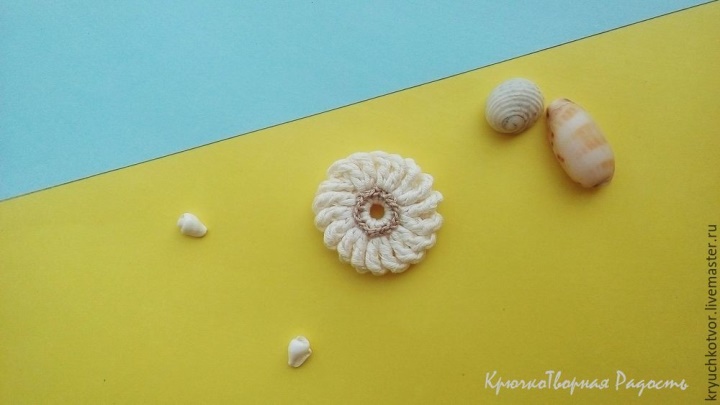
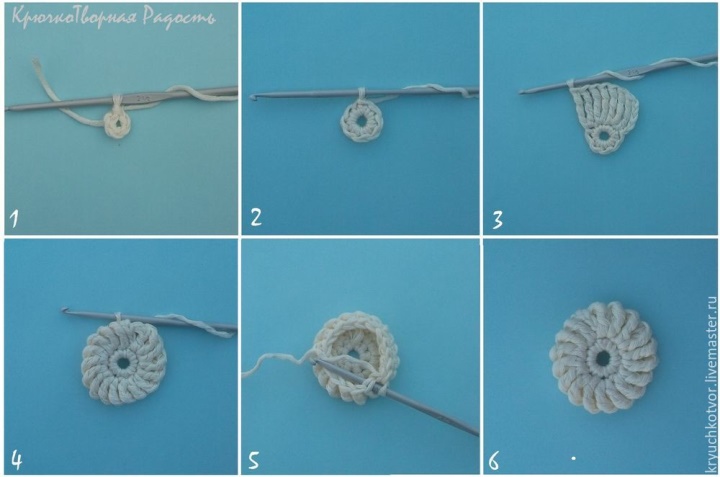
We dial a chain of five air loops, we enclose in a ring.
We make one lifting loop and knit eight columns in this ring without a crochet, we close the row with a connecting post.
We knit five lifting loops, and then two bars with three crochets in each column without a crochet of the previous row.
We close the series with a connecting post.
Our circle was slightly concave; we will strengthen the effect by tying a row of half-columns without a crochet one by one into each column with the three rows of the previous row.
Slightly flatten our shell and turn it clockwise to create a spiral effect.
We will tie the center of the shell with a thin thread in the way that is customary for us.
We knit a shell-oval

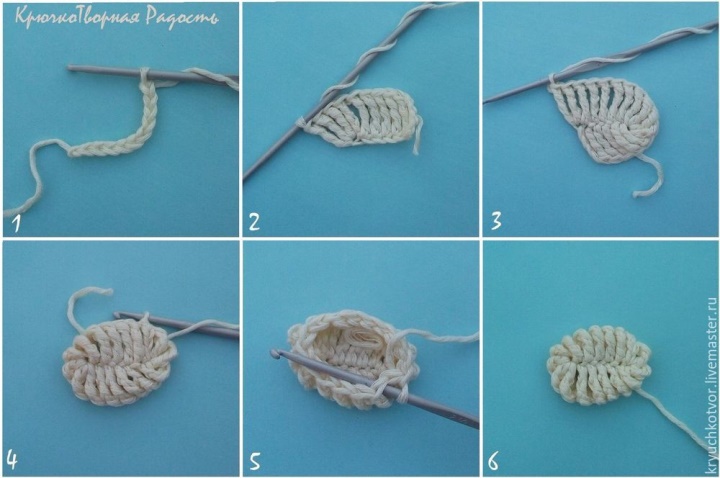
We dial a chain of six air loops plus five lifting loops.
In each loop of the chain, starting from the sixth from the hook, we knit a column with three crochets, and in the last loop - four bars with three crochets.
We turn knitting and knit on a column with three crochets from the opposite side of the chain, and in the last loop - three bars with crochets.
We close the circle with a connecting column in the lifting loops.
A concave oval was obtained; Strengthen the effect by tying a row of half-columns without a crochet one by one into each loop of the base of the previous row.
Slightly flatten our shell and turn it clockwise to create a spiral effect.
We tie the center line of the shell in the way we used.
We knit a big starfish


We dial a chain of five air loops, we close in a ring, we make three loops of lifting and we knit nine columns with a crochet in this ring; close the row with a connecting bar.
We make one lifting loop, we knit one column without a crochet in the next loop of the base, we pass one loop, we knit a column with a crochet on the second from the hook the loop of the base; and then we dial a chain of ten air loops plus one lifting loop.
We knit this chain consistently: one half-column without a crochet, one column without a crochet, one half-pile with a crochet, four sticks with one cuff, three sticks with two crochets.
In the same loop of the base of the circle, as the previous column with a crochet, we knit another column with a crochet, not tying it to the end; then in the second loop of the base we knit a second unbound column with a crochet.
We send these two bars together, connecting them with vertices.
Again, we dial a chain of eleven air loops and in the same way we knit the next ray of the star, in total there are five of them; we close the row with a connecting column in the very first column with the crochet of this row.
We tie a thin thread around the contour already known to us.
We knit a small starfish


We select a chain of five air loops, close it in a ring, make two lifting loops and knit five pairs of columns with one overtone, closed together (two lifting loops are counted as one column with a crochet), dividing these pairs into chains of four air loops.
We close the series with a connecting post.
We make one lifting loop and knit a top of the joined columns with a crochet of the previous row one column without a crochet, and then we select a chain of six air loops.
We knit in this chain consecutively, starting from the third from the hook of the column: one column without a crochet, one half-column with a crochet, one column with a crochet, one column with two crochets.
We make one column without the crochet on the next vertex of the connected columns with the crochets of the previous row.
Similarly we knit the remaining four rays of our star, close the row with a connecting column.
We tie an asterisk along the contour with a thin thread in the way we used.
We knit the ophiuro
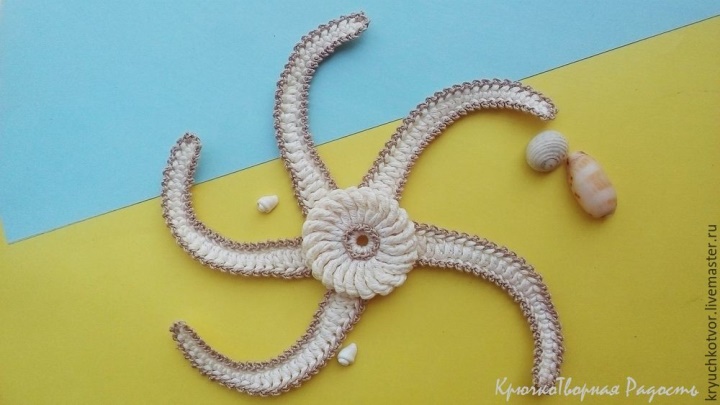
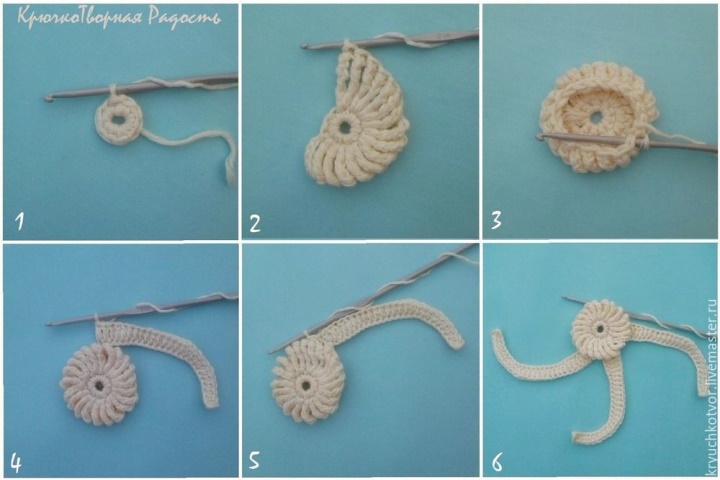
We select a chain of five air loops, close it in a ring, make one lifting loop and knit ten columns in this ring without a crochet: we close the row with a connecting post.
We knit six lifting loops, and then two columns with four rounds in each column without the cusp of the previous row; close the row with a connecting bar.
A slightly concave circle was obtained; Strengthen the effect by tying a number of half-columns without a crochet one by one into each column with the four outlines of the previous row.
Next, we pick up a chain of twenty-five air loops plus one lifting loop and knit this chain sequentially, one post in each loop: ten posts without a crochet, ten half-columns with a crochet, five bars with a crochet.
We connect the connecting column to the third loop of the base of the previous row and one half-shell without the crochet into the next loop.
Similarly, we knit the remaining four rays of the ophiuroids; a little secret - so that they curled beautifully clockwise, a chain of air loops is typed more tightly, and the tops of the columns are knitted more freely.
We bind the rays of the ophiura and its center with a thin thread, in the way we used in the usual way.
And so quickly, beautifully and with pleasure, we procure the necessary quantity of marine elements for us. I contacted five spiralaches, six pieces of bivalves and cones, seven nautilus, one round-keg and two oval, one small starfish and two big ones, and one beautiful ophiuroid. Here is such a bunch!